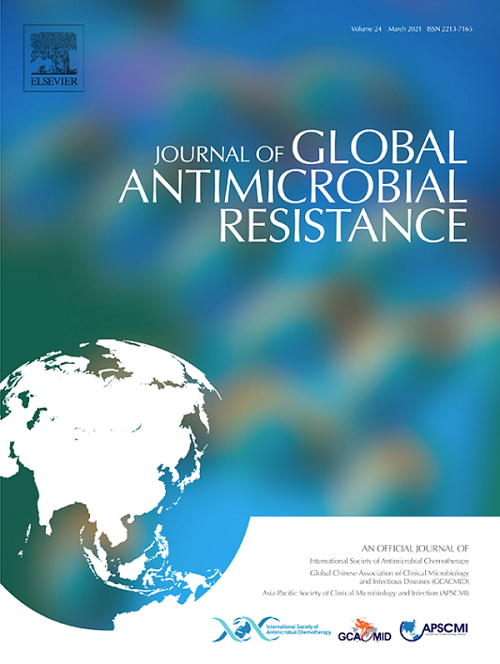Detection of a genetically related carbapenemase-producing Escherichia coli ST167 in clinical and environmental isolates: Evidence for clonal spread of carbapenemase-producing Enterobacteriaceae in humans and the environment in Iowa, United States
IF 3.2
3区 医学
Q2 INFECTIOUS DISEASES
引用次数: 0
Abstract
Background
Carbapenemase-producing Enterobacteriaceae (CPE) are listed by the World Health Organization as one of the critical priority pathogens needing urgent attention to address global resistance to antimicrobials. Thus, the transmission and epidemiology of CPEs need to be studied via One Health perspectives.
Methods
An environmental CPE, referred to as BO1, was isolated from a creek in Northwest Iowa using a Colilert system (IDEXX, Westbrook, ME, USA). The presence of carbapenemase was examined using the modified carbapenem inactivation test, and then phenotypic resistance was determined using a Sensititre Complete Automated AST System (Thermo Fisher Scientific, Roskilde, Denmark). Whole-genome sequencing was performed and analysed to compare with clinical CPEs.
Results
BO1, carrying blaNDM-5, was isolated from a creek in Northwest Iowa. BO1 exhibited resistance to 15 antimicrobials and was defined as an extensively drug-resistant organism. BO1 was also identified as ST167, which is well known as an emerging high-risk clone, and IncFIA- and IncQ1-type conjugatable plasmids were identified within the BO1 genome. The genetic environment of blaNDM-5 was highly conserved as blaNDM-bleMBL-trpF-dsbD in all strains studied. Interestingly, single-nucleotide polymorphism analysis revealed that BO1 shared only 1, 4 and 12 single-nucleotide polymorphisms with three different clinical strains from patients at Iowa health care facilities.
Conclusions
The occurrence of BO1 was temporally and spatially close to that of one clinical strain, IA0018, implying the clonal spread of CPEs among humans and the environment, although the source and directionality of this spread remains unknown. This report illustrates the need for the strict control of CPEs in health care facilities and continuous surveillance within clinical and environmental settings to trace and prevent CPE transmission.
临床和环境分离株中产生碳青霉烯酶的基因相关大肠杆菌ST167的检测:美国爱荷华州cpe在人类和环境中克隆传播的证据
背景:产碳青霉烯酶肠杆菌科(CPE)被世界卫生组织列为需要紧急关注的关键优先病原体之一,以解决全球抗微生物药物耐药性问题。因此,CPEs的传播和流行病学需要从一个健康的角度来研究。方法:采用Colilert系统从爱荷华州西北部的一条小溪中分离出一种环境CPE,称为BO1。通过mCIM检测碳青霉烯酶的存在,然后使用Sensititre™全自动AST系统测定表型抗性。进行全基因组测序并与临床cpe进行比较分析。结果和讨论:携带blaNDM-5的BO1从爱荷华州西北部的一条小溪中分离出来。BO1对15种抗菌素具有耐药性,被定义为广泛耐药生物。BO1被鉴定为ST167,这是一个众所周知的新兴高风险克隆。在BO1基因组中鉴定出了IncFIA和IncQ1型共轭质粒。在所有菌株中,blaNDM-5的遗传环境高度保守为blandm - blemll - trpf - dsbd。有趣的是,单核苷酸多态性(SNP)分析显示,BO1与爱荷华州医疗机构患者的三种不同临床菌株仅共享1、4和12个SNP。结论:BO1的发生时间和空间与临床菌株IA0018的发生时间和空间接近,提示cpe在人群和环境中克隆传播,但传播的来源和方向尚不清楚。该报告说明,需要严格控制医疗机构中的CPE,并在临床和环境环境中进行持续监测,以追踪和预防CPE传播。
本文章由计算机程序翻译,如有差异,请以英文原文为准。
求助全文
约1分钟内获得全文
求助全文
来源期刊

Journal of global antimicrobial resistance
INFECTIOUS DISEASES-PHARMACOLOGY & PHARMACY
CiteScore
8.70
自引率
2.20%
发文量
285
审稿时长
34 weeks
期刊介绍:
The Journal of Global Antimicrobial Resistance (JGAR) is a quarterly online journal run by an international Editorial Board that focuses on the global spread of antibiotic-resistant microbes.
JGAR is a dedicated journal for all professionals working in research, health care, the environment and animal infection control, aiming to track the resistance threat worldwide and provides a single voice devoted to antimicrobial resistance (AMR).
Featuring peer-reviewed and up to date research articles, reviews, short notes and hot topics JGAR covers the key topics related to antibacterial, antiviral, antifungal and antiparasitic resistance.
 求助内容:
求助内容: 应助结果提醒方式:
应助结果提醒方式:


